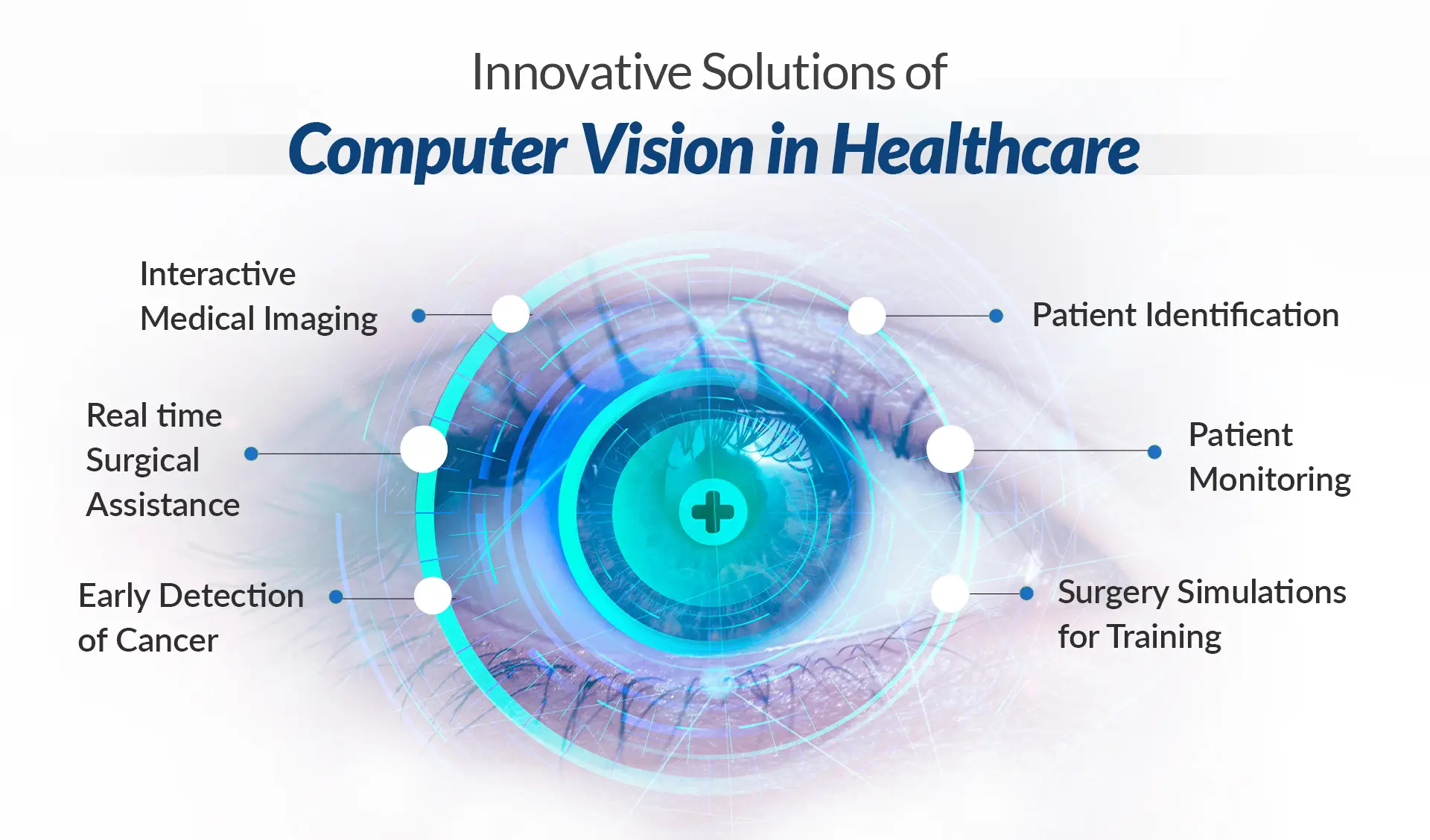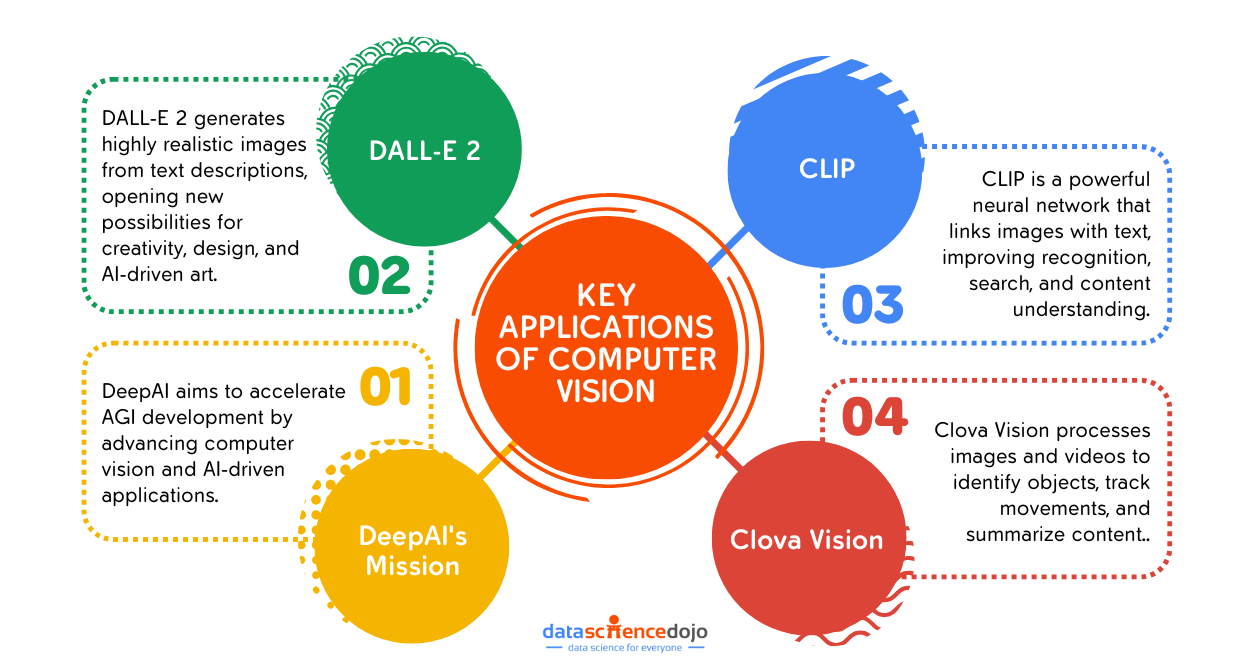Computer vision is a rapidly growing field with a wide range of applications. In recent years, there has been a significant increase in the development of computer vision technologies, and this trend is expected to continue in the coming years.
As computer vision technology continues to develop, it has the potential to revolutionize many industries and aspects of our lives. By enabling machines to interpret and analyze visual data, computer vision applications have evolved far beyond simple object recognition.
This cutting-edge field is driving breakthroughs in sectors such as healthcare, retail, transportation, and security, revolutionizing operations and enhancing everyday experiences. This blog explores the key applications of computer vision that are set to define the technological landscape and transform the way we interact with the world.
Computer Vision Technologies
Computer vision is redefining the way machines perceive and interact with the world, unlocking new levels of automation, accuracy, and efficiency. From enhancing transportation safety to improving medical diagnostics and optimizing manufacturing processes, this technology is driving significant advancements across various sectors.
By leveraging deep learning and AI-driven analysis, computer vision is enabling smarter decision-making, reducing human error, and streamlining operations. In this section, we will explore some of the most transformative applications of computer vision and how they are shaping the future of different industries.
Self-Driving Cars: A Game-Changer
Self-driving cars are one of the most exciting and promising applications of computer vision. These cars use cameras and other sensors to perceive their surroundings and navigate without human input.
Computer vision is essential for self-driving cars to identify objects on the road, such as other cars, pedestrians, and traffic signs. It also helps them to track their location and plan their route.
Beyond navigation, computer vision enables these vehicles to make split-second decisions in dynamic environments, ensuring passenger safety and reducing the likelihood of accidents.
By integrating advanced algorithms and real-time data processing, self-driving cars are set to revolutionize transportation, offering greater convenience, efficiency, and sustainability for the future.
Explore the top 7 Computer Vision books
Healthcare: Diagnosing and Innovating
Computer vision is also being used in a variety of healthcare applications. For example, it can be used to diagnose diseases, such as cancer and COVID-19. Computer vision can also be used to track patient progress and identify potential complications.

By analyzing medical images like X-rays, MRIs, and CT scans, it enables healthcare providers to detect abnormalities with greater accuracy and speed. In addition, computer vision is being used to develop new surgical techniques and devices, such as robotic surgery systems that assist surgeons with precision and enhance patient outcomes.
As the technology evolves, its applications in personalized medicine and predictive diagnostics are expected to further transform the healthcare sector.
Understand how AI in healthcare has improved patient care
Manufacturing: Quality Control and Efficiency
Computer vision is also being used in manufacturing to improve quality control and efficiency. For example, it can be used to inspect products for defects and to automate tasks such as assembly and packaging.
In addition, computer vision is revolutionizing production lines by enabling predictive maintenance, where potential equipment failures are detected before they occur. This reduces downtime and increases operational efficiency.
Computer vision is also being used to develop new manufacturing processes and materials, allowing businesses to innovate faster and remain competitive. By integrating advanced machine vision systems, manufacturers can achieve higher precision, lower costs, and greater sustainability in their operations.
Key Applications of Computer Vision: DeepAI and Cutting-Edge Technologies
DeepAI’s Mission
DeepAI is a pioneering research lab established by Ilya Sutskever, a former research scientist at Google Brain and a leading figure in artificial intelligence. The lab is dedicated to advancing the development of artificial general intelligence (AGI), with a core mission to make AI more accessible, efficient, and user-friendly.
By democratizing AI technologies, DeepAI aims to accelerate innovation across industries and empower developers, businesses, and researchers with powerful AI-driven tools.
One of DeepAI’s primary areas of expertise is computer vision. DeepAI has developed a number of cutting-edge computer vision technologies, including:
DALL-E 2: Transforming Text into Images
DALL-E 2 is a powerful neural network developed by OpenAI that generates realistic and creative images from text descriptions. Using deep learning, it translates written prompts into high-quality visuals, including photorealistic scenes and artistic illustrations.
This AI model understands complex details like textures, colors, lighting, and spatial arrangements. It can accurately generate images that align with specific descriptions, producing visually striking results.
For example, if given the prompt “a photorealistic painting of a cat riding a unicycle,” DALL-E 2 creates an image that captures every detail, from the cat’s posture to the artistic style requested.
Beyond creativity, DALL-E 2 has practical applications in marketing, design, game development, and content creation. It allows users to generate unique visuals effortlessly, revolutionizing digital content creation.
CLIP: Matching Images and Text
CLIP (Contrastive Language-Image Pretraining) is a powerful neural network developed by OpenAI that links images with text descriptions. It enables AI to understand visual content in a way similar to how humans associate words with objects.
By analyzing both text and image data, CLIP can recognize objects, scenes, and concepts without the need for extensive labeled datasets. It learns from vast amounts of internet data, allowing it to generalize across a wide range of images.
For example, if given a picture of a cat and the text “a furry animal with four legs,” CLIP can accurately match the description to the image, identifying it as a cat. Unlike traditional image classification models, CLIP does not rely on predefined categories but instead understands visual elements based on natural language cues.
This technology has significant applications in content search, automated image tagging, and accessibility tools. It enhances AI’s ability to interpret and categorize visual information, improving user experiences across various industries.
Clova Vision: Extracting Information From Visual Media
Clova Vision is a powerful computer vision API designed to extract meaningful information from images and videos. It enables AI-driven analysis, allowing machines to interpret visual content with high accuracy.
This technology can identify objects in images, recognize patterns, and track movements in videos. It processes visual data efficiently, making it a valuable tool for automation and real-time analysis.
For example, Clova Vision can detect objects in an image, follow their movement in a video, or generate a summary of video content. This makes it useful for applications such as security surveillance, media analysis, and smart content management.
With its ability to analyze vast amounts of visual data, Clova Vision enhances automation in industries like e-commerce, healthcare, and entertainment, improving efficiency and decision-making.
Applications of DeepAI’s Technologies
DeepAI’s advanced AI models are transforming various industries by enhancing automation, efficiency, and creativity. From content generation to security and healthcare, these technologies are unlocking new possibilities.
- Content Creation & Design: DALL-E 2 enables artists, marketers, and businesses to generate high-quality visuals from text descriptions. It helps in graphic design, advertising, and media production, reducing the need for manual illustration.
- Image & Video Recognition: Clova Vision extracts meaningful insights from images and videos, making it useful in security surveillance, media analysis, and automated content tagging. It helps businesses manage visual data more efficiently.
- Search & Recommendation Systems: CLIP enhances image search and recommendation engines by matching images with relevant text descriptions. It improves user experiences on e-commerce platforms, social media, and digital libraries.
LLM Use-Cases: Top 10 industries that can benefit from using large language models
- Retail & E-Commerce: AI-driven vision tools are revolutionizing retail by enhancing customer experiences and operational efficiency. Retailers use computer vision for automated checkout systems, inventory management, and personalized shopping recommendations. AI can also analyze shopper behavior to optimize store layouts and marketing strategies.
- Security & Surveillance: DeepAI’s technologies are playing a crucial role in security by enabling facial recognition, anomaly detection, and real-time threat monitoring. AI-powered surveillance systems can identify suspicious activities, track individuals, and enhance overall safety in public spaces, businesses, and homes.
- Accessibility & Assistive Technology: Computer vision helps visually impaired individuals by converting images into descriptive text or voice output. This improves accessibility in education, communication, and daily life.
DeepAI’s computer vision technologies are still under development, but they have the potential to revolutionize a wide range of industries. As DeepAI’s technologies continue to improve, we can expect to see even more innovative and groundbreaking applications in the years to come.
Ready to Transform Lives with Computer Vision?
Computer vision is a powerful technology with a wide range of applications, revolutionizing industries and enhancing everyday experiences. From making autonomous vehicles safer to enabling early disease detection in healthcare, computer vision technologies are reshaping the way we interact with the world.
As these technologies continue to advance, they will unlock new possibilities in security, retail, manufacturing, and beyond. The impact of computer vision extends far beyond machines recognizing images—it’s about transforming lives, improving efficiency, and creating a smarter future. Are you ready to be part of this transformation?








